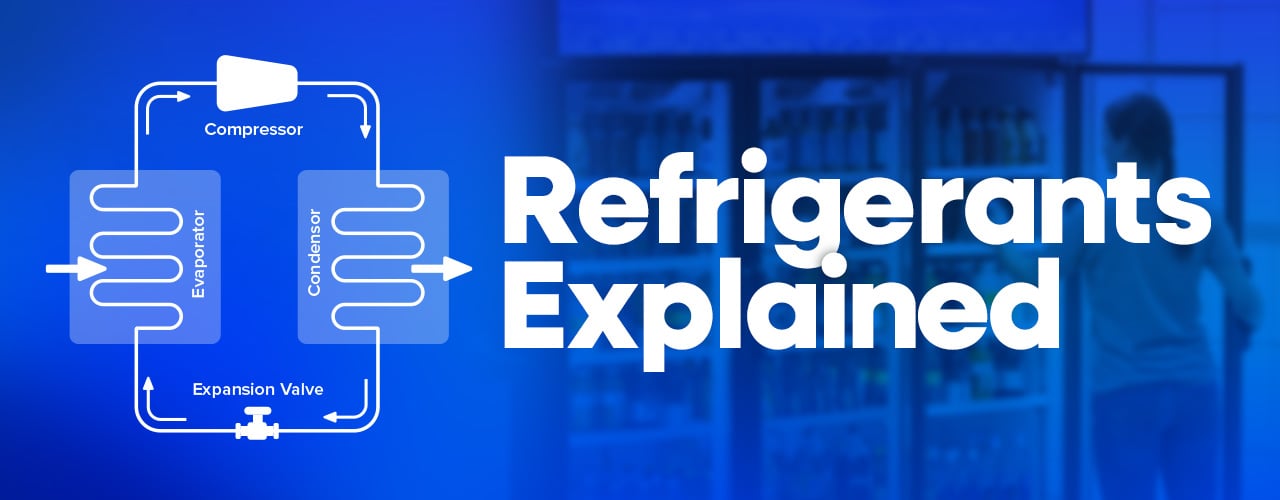
Refrigerants are crucial for commercial refrigeration systems, responsible for cooling and preserving perishable items. With refrigerant regulations phasing out ozone-depleting refrigerants, such as R-22, many businesses are transitioning to more environmentally friendly options. Understanding the different types of refrigerants available for commercial use can help you make an informed decision when it comes to replacing your refrigerator or freezer.
Shop All Commercial RefrigeratorsWhat Is Refrigerant?
Refrigerant is a cooling agent that absorbs heat and leaves cool air behind when passed through a compressor and evaporator. It undergoes a continuous cycle of compression and expansion where the coolant fluctuates between a liquid or gas state as it goes through the thermodynamic process to transfer heat efficiently.
How Refrigerant Works

Here is how refrigerant cools the inside of refrigerators and the air for AC units:
- The refrigerant begins as a liquid when it passes through the expansion device in your unit. It expands and cools due to the sudden drop in pressure causing it to turn into a gas.
- As the gaseous refrigerant passes through the copper evaporator coil inside the unit, it absorbs the heat from the products inside.
- The unit’s compressor then pulls the refrigerant gas and the absorbed heat away from the food products, increasing the pressure of the gas.
- The hot, high-pressure refrigerant then passes through the condenser coils. As it does so, it radiates its heat into the atmosphere and cools back into a liquid.
- The liquid refrigerant reenters the expansion device and the process begins again.
Types of Refrigerant

Common types of refrigerants include synthetic compounds like hydrofluorocarbons (HFCs), hydrochlorofluorocarbons (HCFCs), and natural compounds like ammonia and carbon dioxide. Each type has its own unique ID number, properties, and environmental impact, making it important for businesses to choose the right refrigerant for their specific needs.
Because of the negative impact on the environment, there are refrigerant regulations in place that have listed a variety of banned refrigerant types that are being phased out and replaced with more environmentally friendly alternatives. A refrigerant’s environmental impact is measured by two main characteristics: Ozone Depletion Potential (ODP) and Global Warming Potential (GWP). ODP measures a refrigerant's impact on the ozone layer, while GWP assesses its contribution to global warming. Choosing refrigerants with lower ODP and GWP values can help businesses reduce their environmental footprint and comply with regulations aimed at mitigating climate change.
- Red = Not Eco-Friendly
- Yellow = Somewhat Eco-Friendly
- Green = Eco-Friendly
1. R-12 Refrigerant
R-12 refrigerant, once the most popular refrigerant on the market, was banned in the early 1990s for contributing to the greenhouse gas effect and all production ceased in 1994.
- Components: Chlorofluorocarbons (CFC), Methane Based
- Uses: Refrigerators and air conditioners
- ODP: 1.0
- GWP: High (10900)
- Eco-Friendly: No
- Flammable: No
- Banned in 1994
2. R-22 Refrigerant
R-22 refrigerant was made in the late 1990s to temporarily replace R-12 due to its lower ODP. Production ceased in 2020, and it will be entirely illegal by 2030 to comply with the Clean Air Act of 2010.
- Components: Hydrochlorofluorocarbons (HCFC), contains less chlorine than CFCs
- Uses: Refrigerators and air conditioners
- ODP: 0.055
- GWP: Medium (1810)
- Eco-Friendly: No
- Flammable: No
- Will be banned by 2030
3. R-134a Refrigerant
R-134a refrigerant, also known as Tetrafluoroethane, is a popular choice for commercial refrigeration systems due to its low toxicity and non-flammability. It is commonly used in medium- and high-temperature applications, such as refrigerators, air conditioning units, and chillers. R-134a has a relatively low OPD compared to other refrigerants but is being phased out in some regions due to its potential contribution to climate change.
- Components: Hydrofluorocarbon (HFC)
- Uses: Refrigerators and car air conditioning
- ODP: 0
- GWP: 1430 (Medium)
- Eco-Friendly: Somewhat
- Flammable: No
4. R-290 Refrigerant
R-290 refrigerant, also known as Care 40, is a type of environmentally friendly refrigerant that adheres to the SNAP program passed by the EPA. This propane-based refrigerant is gaining popularity as a replacement for R-22, R-134a, and R-404. It is often used in ENERGY STAR appliances. However, it's important to note that R-290 may have shipping restrictions due to its flammable nature.
- Components: Hydrocarbons (HC), Propane based
- Uses: Refrigerators and air conditioners
- ODP: 0
- GWP: Low (6)
- Eco-Friendly: Yes
- Flammable: Yes
5. R-404A Refrigerant
R-404A refrigerant is a non-ozone-depleting blend of HFC refrigerants that offers high-efficiency performance in a wide range of applications. It is commonly used in supermarket refrigeration, cold storage warehouses, and industrial refrigeration systems. Due to its high GWP, R-404A is not considered to be an environmentally friendly option.
- Components: Hydrofluorocarbon (HFC)
- Uses: Freezers and refrigerators
- ODP: 0
- GWP: High (3922)
- Eco-Friendly: No
- Flammable: No
6. R-410A Refrigerant
R-410A refrigerant, also known as Puron, is a popular choice for commercial refrigeration and air conditioning systems. This refrigerant is a hydrofluorocarbon (HFC) blend that does not contain chlorine and was used as a replacement for older, ozone-depleting refrigerants. However, R-410A is set to be phased out by 2025 in compliance with the 2020 EPA regulations aimed at reducing the use of hydrochlorofluorocarbons (HCFCs).
- Components: Hydrofluorocarbon (HFC)
- Uses: Refrigerators and air conditioners
- ODP: 0
- GWP: Medium (2088)
- Eco-Friendly: Somewhat
- Flammable: No
- Will be phased out by 2025
7. R-450A Refrigerant
R-450A refrigerant was developed as a direct replacement for R-134a, offering a high-efficiency and non-flammable alternative. This refrigerant is ideal for use in refrigerators, beverage dispensers, vending machines, and water chillers, making it a versatile choice for various commercial applications.
- Components: Hydrofluoroolefin (HFO)
- Uses: Refrigerators and car air conditioning
- ODP: 0
- GWP: Medium (547)
- Eco-Friendly: Yes
- Flammable: No
8. R-454B Refrigerant
R-454B refrigerant is a new zeotropic coolant that serves as an environmentally friendly replacement for R-410A. It is non-toxic and safe to use indoors, offering a GWP compared to other refrigerants. However, it is important to note that R-454B is somewhat flammable, so proper precautions should be taken when handling and storing this refrigerant.
- Components: Difluoromethane and 2,3,3,3-tetrafluoropropene
- Uses: Air conditioners and heat pumps
- ODP: 0
- GWP: Medium (466)
- Eco-Friendly: Yes
- Flammable: Yes
9. R-513a Refrigerant
R-513a refrigerant, also known as Opteon XP10, is a hydrofluoroolefin (HFO) refrigerant that is non-flammable and low GWP. It is commonly used as a replacement for R-134a in various commercial refrigeration applications due to its environmental friendliness and energy efficiency. R-513a has a GWP of less than 600, making it a sustainable choice for businesses looking to reduce their carbon footprint.
- Components: Hydrofluoroolefin (HFO)
- Uses: Air conditioners and refrigerators
- ODP: 0
- GWP: Medium (573)
- Eco-Friendly: Yes
- Flammable: No
10. R-600a Refrigerant
R-600a, also known as isobutane, is a hydrocarbon refrigerant commonly used in commercial refrigeration systems. This natural refrigerant is environmentally friendly, with zero ozone depletion potential and low global warming potential. R-600a is highly efficient at cooling and is a cost-effective option for businesses looking to reduce their carbon footprint. Its flammable nature requires proper handling and installation procedures to ensure safety in commercial applications.
- Components: Hydrocarbon (HC)
- Uses: Residential and small commercial refrigerators
- ODP: 0
- GWP: Low (3)
- Eco-Friendly: Yes
- Flammable: Yes
Refrigerant-Related Acronyms
- CAA: Clean Air Act
- CFC: Chlorofluorocarbon, an unsafe refrigerant made of carbon, chlorine, and fluorine
- EPA: Environmental Protection Agency
- HC: Hydrocarbon, chemical containing hydrogen and carbon
- GWP: Global warming potential
- HCFC: Hydrochlorofluorocarbon, compound made of carbon, hydrogen, chlorine, and fluorine
- HFC: Hydrofluorocarbon, chemical made of carbon, hydrogen, and fluorine
- HFC-32: Difluoromethane, an environmentally-friendly refrigerant used in flammable refrigerants
- HFO: Hydrofluoroolefin, newer generation of refrigerants composed of hydrogen, fluorine, and carbon
- R12: Banned methane-based refrigerant
- R22: Replacement refrigerant for R12, will be illegal by 2030
- R134a: Tetrafluoroethane refrigerant that is somewhat eco-friendly
- R290: Environmentally friendly refrigerant known as Care 40
- R404A: Non-ozone-depleting blend of HFC refrigerants but not eco-friendly
- R410A: Puron, will be phased out by 2025
- R450A: Replacement for R134a, eco-friendly and non-flammable
- R454B: Zeotropic coolant, replacement for R410A
- R513a: Opteon XP10, non-flammable with a low GWP
- R600a: Isobutane, natural refrigerant is environmentally friendly
- SNAP: The EPA's Significant New Alternatives Policy program
Understanding the different types of refrigerants is crucial for businesses in the foodservice industry to ensure proper refrigeration and compliance with regulations. From traditional options like R-22 to more environmentally friendly alternatives such as R-450A and R-454B, each refrigerant has its own set of benefits and considerations. By staying informed about the various types of refrigerants available, you can find the best commercial refrigeration for your business.





